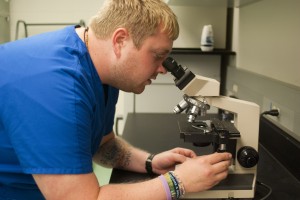Meramec student studies infinite stem cell possibilities

Amber Davis
-Asst. Art & Life Editor-
While most high school students were cramming for tests, worrying about homecoming or procrastinating, Matt Lindsey, a STLCC-Meramec student, started lab work for stem cell research.
“In my high school I worked in an independent study class, which was called Authentic Science Research with my teacher Cheryl Epperson. It was a three-year class so you started your sophomore year,” Lindsey said.
The program Lindsey participated in lead him to his mentor Gerhard Bauer. Bauer was the director for the Good Manufacture Practice Facility which was located in the cancer facility at Washington University. Lindsey then became a lab technician with Bauer to monitor an “ultra-clean facility.”
“My job [in the ultra-clean facility] was to transfect stem cells. When they divided to white and red cells, I wanted to see if they still maintain that gene that I inserted into them,” Lindsey said.
Not only did Lindsey monitor dividing blood cells, he also had to make sure temperatures were right and he had to measure the levels of bacteria inside the incubators. The purpose was to protect the study from contamination by outside bacteria or certain amount of particles in the air.
“We had to clean out water vats so a bacterium was not growing in [the study],” Lindsey said. “Then I had to do settling plates that allowed when the air flow bacteria particles in the air will fall on the settling plate if it grew a certain amount of colonies, (above 3 colonies) then it was considered to fail. From there, we had to do a whole cleaning of the facility to decontaminate them. So there would be no contamination into the samples that we would be transplanting into a patient.”
One patient had to come in regularly to Washington University for blood transfusions.
“He was deficient to platelets and we could produce enough of them and give him a high concentration of these platelets. With these stem cells that he would not have to come in for treatment as much,” Lindsey said.
Once Lindsey graduated from high school in 2007, he joined his mentor Bauer to move to Sacramento, Ca. Lindsey attended school at the University of California-Davis (UC Davis). Lindsey also helped Bauer with his stem cell research program while in Sacramento.
“When I graduated, I moved out there with them and I became the staff research associate. I took on more responsibilities; I developed different processes for deriving Mesenchymal stem cells from the umbilical cord blood and from the placenta,” Lindsey said.
During the time Lindsey lived in California, George Bush was in office. Bush did not allow embryotic stem cell research due to ethnical issues. Once President Obama was elected into office, the spring of 2008, he eliminated the barrier for stem cell research.
“That was a pretty exciting time and we were a new stem cell program. [The program] was on the leading edge of everything,” Lindsey said.
With having success, several local news crews would come into UC Davis Stem Cell Program to do stories.
Lindsey and his crew would give their input about how they felt stem cell research could help society.
“I really feel that our work out [in Sacramento] does have much potential for many people with fatal diseases; such as Huntington’s disease and HIV,” Lindsey said.
Lindsey’s research at UC Davis was to track the progress of the stem cells while inserted into the test rats and primates. One experiment Lindsey conducted was to cut the femoral artery (the largest artery located in the thigh) on their test rats. The Mesenchymal stem cells were inserted into the femoral that allowed other cells to come in the injured area, which released new capillaries or blood vessels. The new blood vessels went around the injury which allowed blood flow to continue down the leg.
“The mouse would have his leg paralyzed; he wouldn’t be able to walk [without the Mesenchymal stem cells]. Twenty-one days after the injection this mouse is having function in his leg again,” Lindsey said.
Lindsey said he has always wanted to go into the medical field. He is getting his prerequisites at Meramec to accomplish his nursing degree. After he gets his prerequisites finished Lindsey plans to move on to Washington University’s Barnes Jewish Hospital School of Nursing. Lindsey said he would then go into a Master’s program.
“I really had a heart for the intensive care units and the ER when I went on career shadowing. But as I worked more in the medical field and saw what nurses do I really enjoyed that environment,” Lindsey said. “Once I specialize in there I definitely want to obtain my Ph.D. and do more of the planning and managing aspects of nursing and eventually get into teaching.”











